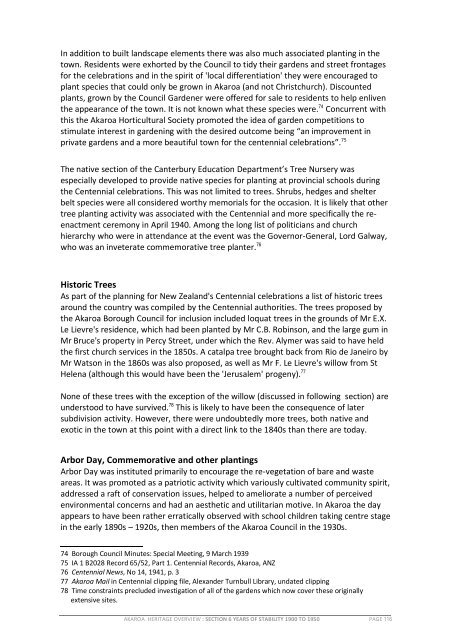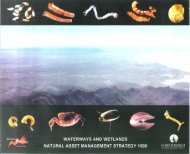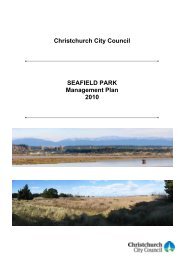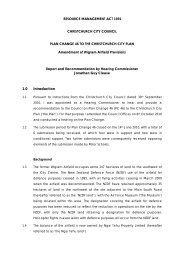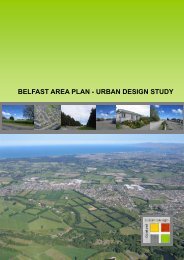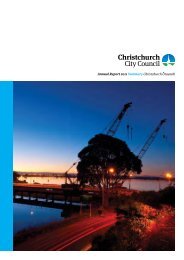Akaroa Historical Overview - Christchurch City Council
Akaroa Historical Overview - Christchurch City Council
Akaroa Historical Overview - Christchurch City Council
You also want an ePaper? Increase the reach of your titles
YUMPU automatically turns print PDFs into web optimized ePapers that Google loves.
In addition to built landscape elements there was also much associated planting in the<br />
town. Residents were exhorted by the <strong>Council</strong> to tidy their gardens and street frontages<br />
for the celebrations and in the spirit of 'local differentiation' they were encouraged to<br />
plant species that could only be grown in <strong>Akaroa</strong> (and not <strong>Christchurch</strong>). Discounted<br />
plants, grown by the <strong>Council</strong> Gardener were offered for sale to residents to help enliven<br />
the appearance of the town. It is not known what these species were. 74 Concurrent with<br />
this the <strong>Akaroa</strong> Horticultural Society promoted the idea of garden competitions to<br />
stimulate interest in gardening with the desired outcome being “an improvement in<br />
private gardens and a more beautiful town for the centennial celebrations”. 75<br />
The native section of the Canterbury Education Department’s Tree Nursery was<br />
especially developed to provide native species for planting at provincial schools during<br />
the Centennial celebrations. This was not limited to trees. Shrubs, hedges and shelter<br />
belt species were all considered worthy memorials for the occasion. It is likely that other<br />
tree planting activity was associated with the Centennial and more specifically the reenactment<br />
ceremony in April 1940. Among the long list of politicians and church<br />
hierarchy who were in attendance at the event was the Governor-General, Lord Galway,<br />
who was an inveterate commemorative tree planter. 76<br />
Historic Trees<br />
As part of the planning for New Zealand's Centennial celebrations a list of historic trees<br />
around the country was compiled by the Centennial authorities. The trees proposed by<br />
the <strong>Akaroa</strong> Borough <strong>Council</strong> for inclusion included loquat trees in the grounds of Mr E.X.<br />
Le Lievre's residence, which had been planted by Mr C.B. Robinson, and the large gum in<br />
Mr Bruce's property in Percy Street, under which the Rev. Alymer was said to have held<br />
the first church services in the 1850s. A catalpa tree brought back from Rio de Janeiro by<br />
Mr Watson in the 1860s was also proposed, as well as Mr F. Le Lievre's willow from St<br />
Helena (although this would have been the 'Jerusalem' progeny). 77<br />
None of these trees with the exception of the willow (discussed in following section) are<br />
understood to have survived. 78 This is likely to have been the consequence of later<br />
subdivision activity. However, there were undoubtedly more trees, both native and<br />
exotic in the town at this point with a direct link to the 1840s than there are today.<br />
Arbor Day, Commemorative and other plantings<br />
Arbor Day was instituted primarily to encourage the re-vegetation of bare and waste<br />
areas. It was promoted as a patriotic activity which variously cultivated community spirit,<br />
addressed a raft of conservation issues, helped to ameliorate a number of perceived<br />
environmental concerns and had an aesthetic and utilitarian motive. In <strong>Akaroa</strong> the day<br />
appears to have been rather erratically observed with school children taking centre stage<br />
in the early 1890s – 1920s, then members of the <strong>Akaroa</strong> <strong>Council</strong> in the 1930s.<br />
74 Borough <strong>Council</strong> Minutes: Special Meeting, 9 March 1939<br />
75 IA 1 B2028 Record 65/52, Part 1. Centennial Records, <strong>Akaroa</strong>, ANZ<br />
76 Centennial News, No 14, 1941, p. 3<br />
77 <strong>Akaroa</strong> Mail in Centennial clipping file, Alexander Turnbull Library, undated clipping<br />
78 Time constraints precluded investigation of all of the gardens which now cover these originally<br />
extensive sites.<br />
AKAROA HERITAGE OVERVIEW : SECTION 6 YEARS OF STABILITY 1900 TO 1950 PAGE 116


